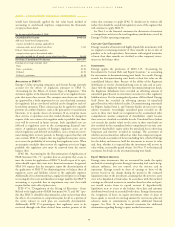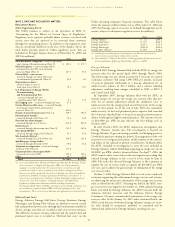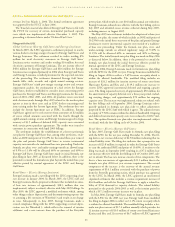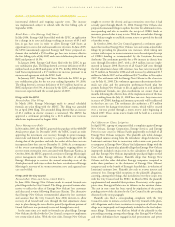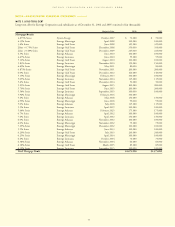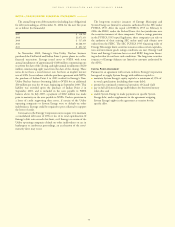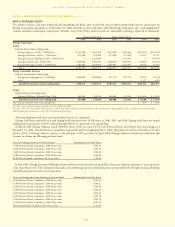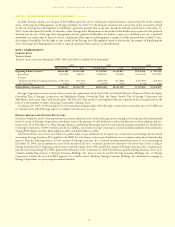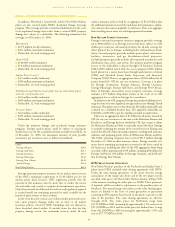Entergy 2006 Annual Report Download - page 85
Download and view the complete annual report
Please find page 85 of the 2006 Entergy annual report below. You can navigate through the pages in the report by either clicking on the pages listed below, or by using the keyword search tool below to find specific information within the annual report.
ENTERGY CORPORATION AND SUBSIDIARIES 2
2000066
issue is the cost and time related to the construction of facilities to
interconnect Entergy Gulf States’ Texas operations with ERCOT,
while addressing the interest of Entergy Gulf States’ retail customers
and certain wholesale customers in access to generation outside of
Texas. With respect to the SPP, the major issue is the development of
protocols that would ultimately be necessary to implement retail open
access. Entergy Gulf States recommended that the PUCT open a proj-
ect for the purpose of involving stakeholders in the selection of the
single power region that Entergy Gulf States should request for certi-
fication. In August 2006, the PUCT staff recommended that Entergy
Gulf States be required to provide additional information on both the
ERCOT option and the SPP option. The PUCT accepted the PUCT
staff’s recommendation and stated the need for a “robust record” to
make a decision on the applicable power region.
As required by the June 2005 legislation, Entergy Gulf States filed
its proposed transition to competition plan in December 2006 and
maintained that to achieve full customer choice, Entergy Gulf States
should join ERCOT since it already has all of the prerequisites for
retail choice. The plan contains several conditions, including cost
recovery mechanisms, that must be met before Entergy Gulf States
could proceed with the plan, and identifies several legislative
requirements needed to accomplish the required infrastructure
improvements. Assuming that these conditions can be met, retail
open access could commence in 2013. Entergy Gulf States’
filing includes an estimate that construction costs for facilities to
interconnect Entergy Gulf States’ Texas operations with ERCOT
could be approximately $1 billion. The PUCT has 180 days to accept,
reject, or modify the plan. The Texas Legislature began its session on
January 9, 2007.
In December 2006, the PUCT asked for parties to brief the effects
of the 2005 legislation on the competition dockets of Entergy Gulf
States, most notably, the settlement that the parties entered with
respect to the unbundling of Entergy Gulf States for retail open
access. Finding that the 2005 legislation now provides the mechanism
by which Entergy Gulf States will transition to competition,
the PUCT, on February 1, 2007, dismissed Entergy Gulf States’
unbundled cost of service proceeding.
CO-OWNER-INITIATED PROCEEDING AT THE FERC
In September 2004, East Texas Electric Cooperative (ETEC) filed a
complaint at the FERC against Entergy Arkansas relating to a contract
dispute over the pricing of substitute energy at the co-owned
Independence coal unit. In October 2004, Arkansas Electric
Cooperative (AECC) filed a similar complaint at the FERC against
Entergy Arkansas, addressing the same issue with respect to
Independence and another co-owned coal unit, White Bluff. FERC
consolidated these cases, ordered a hearing in the consolidated pro-
ceeding, and established refund effective dates. The main issue in the
consolidated case relates to the consequences under the governing
contracts when the dispatch of the coal units is constrained due to sys-
tem operating conditions. In August 2005, Entergy Arkansas and
ETEC filed a settlement at the FERC that resolved all issues in dis-
pute between ETEC and Entergy Arkansas. As part of the settlement,
ETEC dismissed its complaint. A hearing was held on the AECC
complaint and an ALJ Initial Decision was issued in January 2006 in
which the ALJ found AECC’s claims to be without merit. On
October 25, 2006, the FERC issued its order in the proceeding. In the
order, the FERC reversed the ALJ’s findings. Specifically, the FERC
found that the governing contracts do not recognize the effects of
dispatch constraints on the co-owned units. The FERC explained that
for over twenty-three years the course of conduct of the parties was
such that AECC received its full entitlement to the two coal units,
regardless of any reduced output caused by system operating
constraints. Based on the order, Entergy Arkansas is required to refund
to AECC all excess amounts billed to AECC as a result of the system
operating constraints. Entergy Arkansas estimates currently that this will
result in a refund to AECC of approximately $26 million, although
Entergy Arkansas is still refining the estimate. In November 2006
Entergy Arkansas filed with the FERC a request for rehearing.
NOTE 3. INCOME TAXES
Income tax expenses from continuing operations for 2006, 2005,
and 2004 for Entergy Corporation and subsidiaries consist of the
following (in thousands):
2006 2005 2004
Current:
Federal $(266,464) $(306,524) $ 67,924
Foreign 64 13,290 (2,231)
State (74,319) (27,212) 38,324
Total (340,719) (320,446) 104,017
Deferred – net 801,745 898,384 282,275
Investment tax credit
adjustments – net (17,982) (18,654) (20,987)
Income tax expense from
continuing operations $ 443,044 $ 559,284 $365,305
Total income taxes from continuing operations for Entergy
Corporation and subsidiaries differ from the amounts computed
by applying the statutory income tax rate to income before taxes.
The reasons for the differences for the years 2006, 2005, and 2004 are
(in thousands):
2006 2005 2004
Computed at statutory rate (35%) $551,650 $525,843 $446,205
Increases (reductions) in tax
resulting from:
State income taxes net of
federal income tax effect 44,230 44,282 36,149
Regulatory differences –
utility plant items 50,211 28,983 41,240
Amortization of investment
tax credits (17,460) (18,691) (20,596)
Capital loss (79,427) (792) (86,426)
Flow-through/permanent
differences (52,866) (23,618) (34,804)
Tax reserves (53,610) – (9,600)
Valuation allowance 22,300 – –
Other – net (21,984) 3,277 (6,863)
Total income taxes
from continuing operations $443,044 $559,284 $365,305
Effective income tax rate 28.1% 37.2% 28.7%
The capital loss for 2006 includes a loss for tax purposes recorded
in the fourth quarter 2006 resulting from the liquidation of Entergy
Power International Holdings, Entergy’s holding company for
Entergy-Koch, LP. The $79.4 million tax benefit is net of other capi-
tal gains. The capital loss for 2004 is a tax benefit resulting from the
sale of preferred stock and less than 1% of the common stock of
Entergy Asset Management, an Entergy subsidiary. In December
2004, an Entergy subsidiary sold the stock to a third party for $29.75
million. The sale resulted in a capital loss for tax purposes of $370
million, producing a federal and state net tax benefit of $97 million
that Entergy recorded in the fourth quarter of 2004. Entergy has
established a contingency provision in its financial statements that
management believes will sufficiently cover the risk associated with
these issues.
NOTESto CONSOLIDATED FINANCIAL STATEMENTS continued
69


